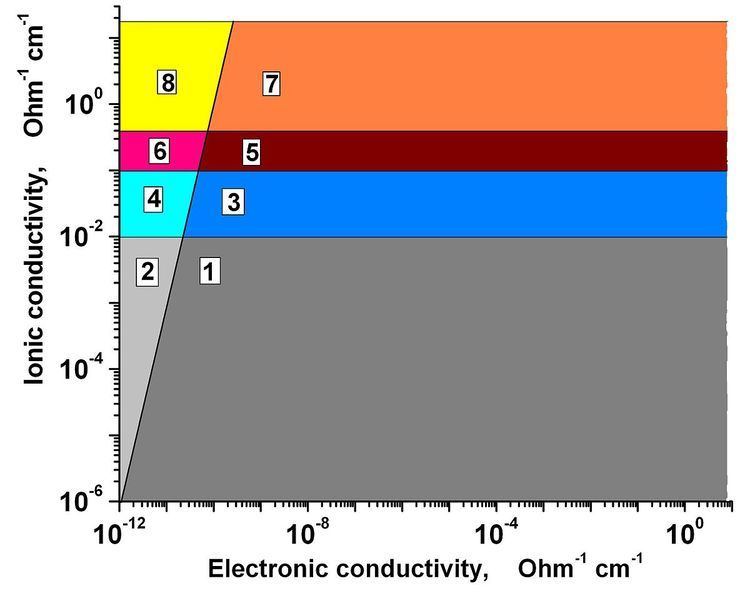 | ||
In materials science, fast ion conductors are solids with highly mobile ions. These materials are important in the area of solid-state ionics, and are also known as solid electrolytes and superionic conductors. These materials are useful in batteries and various sensors. Fast ion conductors are used primarily in solid oxide fuel cells. As solid electrolytes they allow the movement of ions without the need for a liquid or soft membrane separating the electrodes. The phenomenon relies on the hopping of ions through an otherwise rigid crystal structure.
Contents
Mechanism
Fast ion conductors are intermediate in nature between crystalline solids which possess a regular structure with immobile ions, and liquid electrolytes which have no regular structure and fully mobile ions. Solid electrolytes find use in all solid-state supercapacitors, batteries, and fuel cells, and in various kinds of chemical sensors.
Classification
In solid electrolytes (glasses or crystals), the ionic conductivity Ωi can be any value, but it should be much larger than the electronic one. Usually, solids where Ωi is on the order of 0.0001 to 0.1 Ohm−1 cm−1 (300 K) are called superionic conductors.
Proton conductors
Proton conductors are a special class of solid electrolytes, where hydrogen ions act as charge carriers.
Superionic conductors
Unlike conventional solid electrolytes and superionic conductors.
Superionic conductors where Ωi is more than 0.1 Ohm−1 cm−1 (300 K) and the activation energy for ion transport Ei is small (about 0.1 eV), are called advanced superionic conductors. The most famous example of advanced superionic conductor-solid electrolyte is RbAg4I5 where Ωi > 0.25 Ohm−1 cm−1 and Ωe ~10−9 Ohm−1 cm−1 at 300 K. The Hall (drift) ionic mobility in RbAg4I5 is about 2×10−4 cm2/(V•s) at room temperatures. The Ωe – Ωi systematic diagram distinguishing the different types of solid-state ionic conductors is given in the figure.
No clear examples have been described as yet, of fast ion conductors in the hypothetical advanced superionic conductors class (areas 7 and 8 in the classification plot). However, in crystal structure of several superionic conductors, e.g. in the minerals of the pearceite-polybasite group, the large structural fragments with activation energy of ion transport Ei < kBT (300 К) had been discovered in 2006.
Zirconia-based materials
A common solid electrolyte is yttria-stabilized zirconia, YSZ. This material is prepared by doping Y2O3 into ZrO2. Oxide ions typically migrate only slowly in solid Y2O3 and in ZrO2, but in YSZ, the conductivity of oxide increases dramatically. These materials are used to allow oxygen to move through the solid in certain kinds of fuel cells. Zirconium dioxide can also be doped with calcium oxide to give an oxide conductor that is used in oxygen sensors in automobile controls. Upon doping only a few percent, the diffusion constant of oxide increases by a factor of ~1000.
Other conductive ceramics function as ion conductors. One example is NASICON, (Na3Zr2Si2PO12), a sodium super-ionic conductor
beta-Alumina
Another example of a popular fast ion conductor is beta-alumina solid electrolyte. Unlike the usual forms of alumina, this modification has a layered structure with open galleries separated by pillars. Sodium ions (Na+) migrate through this material readily since the oxide framework provides an ionophilic, non-reducible medium. This material is considered as the sodium ion conductor for the sodium–sulfur battery.
Fluoride ion conductors
Lanthanum trifluoride (LaF3) is conductive for F− ions, used in some ion selective electrodes. Beta-lead fluoride exhibits a continuous growth of conductivity on heating. This property was first discovered by Michael Faraday.
Iodides
A textbook example of a fast ion conductor is silver iodide (AgI). Upon heating the solid to 146 °C, this material adopts the alpha-polymorph. In this form, the iodide ions form a rigid cubic framework, and the Ag+ centers are molten. The electrical conductivity of the solid increases by 4000x. Similar behavior is observed for copper(I) iodide (CuI), rubidium silver iodide (RbAgI2), and Ag2HgI4.
Other Inorganic materials
Organic materials
History
The important case of fast ionic conduction is one in a surface space-charge layer of ionic crystals. Such conduction was first predicted by Kurt Lehovec. As a space-charge layer has nanometer thickness, the effect is directly related to nanoionics (nanoionics-I). Lehovec's effect is used as a basis for developing nanomaterials for portable lithium batteries and fuel cells.
